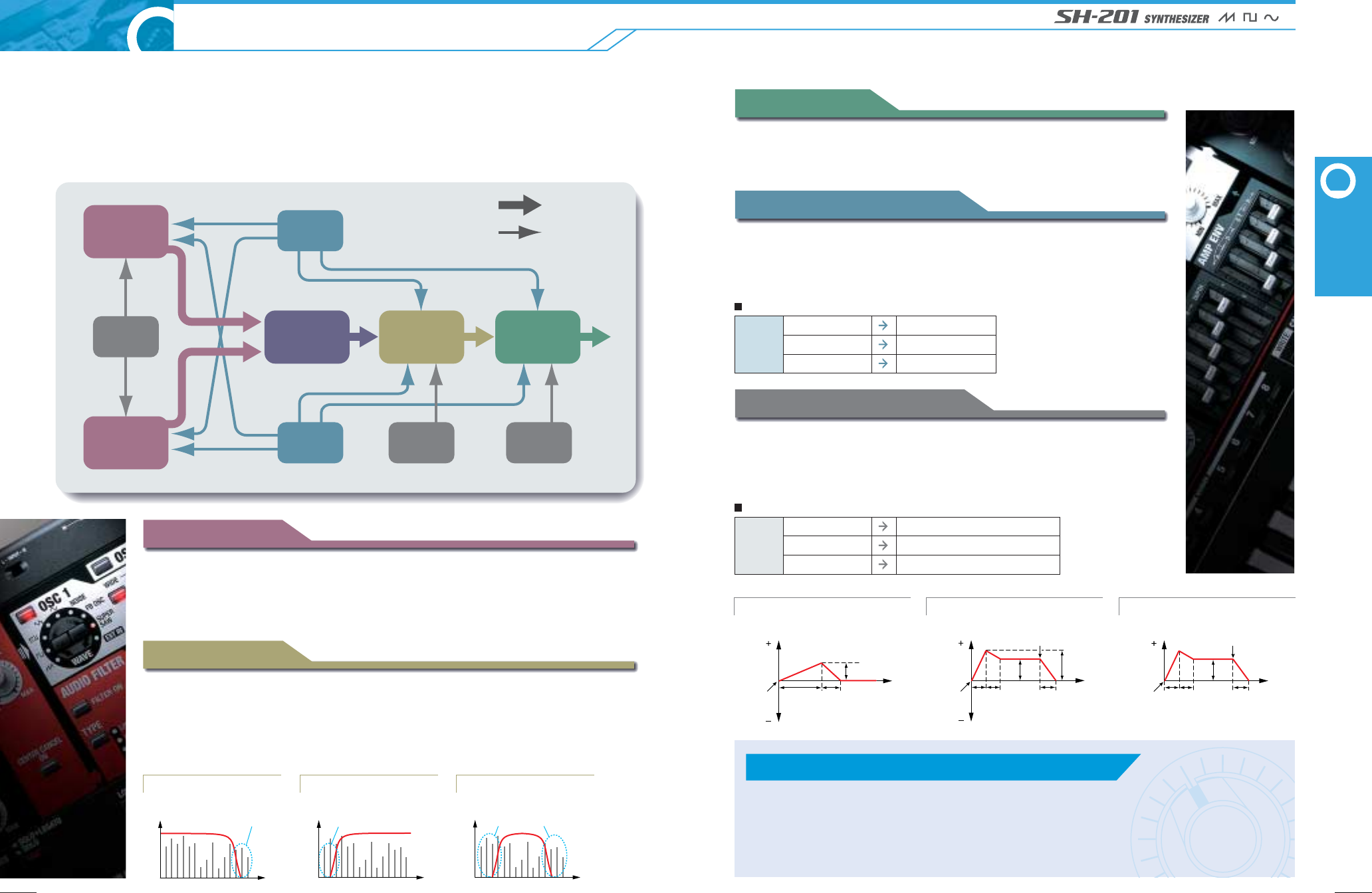
A typical synthesizer will have a signal flow-chart
similar to the one pictured below.
To start, let’s understand the fundamentals.
Oscillator
(
➝ P. 9
)
OSC
This is the basis of the sound, where the waveform and pitch are selected. It is indeed
the heart and soul of a synthesizer. On analog synthesizers, it is called the VCO
(*1)
. A VCO is
a sound generator capable of changing frequency through changes in voltage. The SH-201
has two oscillators (OSC1 and OSC2). It’s like having two synthesizers in one.
AMP
Sound generated in OSC and processed through the FILTER is amplified here.
On analog synthesizers, it is called the VCA
(*3)
. The VCA is used to change
the volume (level) of sound signal through changes in voltage.
FILTER
This is where the sound signal generated from the OSC is processed through the emphasis
and rejection of a selected frequency range. On analog synthesizers, it is called the VCF
(*2)
.
A VCF is used to continuously change the characteristics of a filter (cutoff frequency)
through changes in voltage. The SH-201 houses three separate filters, each designed
for a specific purpose.
Low Frequency Oscillator
(
➝ P. 15
)
LFO
This is a sound generator capable of producing low frequencies. On analog
synthesizers, it is also called the LFO
(*4)
. The LFO affects the OSC, FILTER, and
AMP individually as it adds modulation. LFO is a “must have” for producing
synthesizer-like effects.
Envelope Generator
(
➝ P. 10, 12, 13
)
ENV
An envelope generator controls the initiation and termination of sounds.
On analog synthesizers, it is also called ENV
(*5)
. Every time you play
the keyboard, ENV affects the volume and timbre on OSC, FILTER, and AMP
individually as it processes its time-varied elements.
time
Key-on
Key-off
cutoff frequency
AD
S
DEPTH
R
Low Pass Filter High Pass Filter Band Pass Filter
Key-on
Key-off
time
AD
S
R
volume
AD
time
DEPTH
Key-on
pitch
LPF BPF
PITCH ENV FILTER ENV AMP ENV
HPF
Examples of LFO
LFO
applied to OSC
applied to FILTER
applied to AMP
Vibrato
WahWah (Growl)
Tremolo
Examples of ENV
ENV
applied to OSC
applied to FILTER
applied to AMP
Pitch becomes higher or lower
Sound becomes brighter or darker
Sound becomes louder or softer
(*1) Voltage Controlled Oscillator (*2) Voltage Controlled Flter (*3) Voltage Controlled Amplifier
(*4) Low Frequency Oscillator (*5) Envelope Generator
2
Chapter
The Basic Structure of a Synthesizer
Audio signals
Control signals
(
➝ P. 11
)
(
➝ P. 13
)
frequency
partials which are cut
level
frequency
level
partials which are cut
frequency
level
partials which are cut
Once considered relics, analog synthesizers are attracting attention once again.
The simple and easy-to-understand OSC ➝ FILTER ➝ AMP structure enables real-time control
to achieve dynamic sound variation. Moving knobs and faders to create your own unique sound can
be a very exciting experience indeed. The SH-201 is recommended not only for keyboardists,
but for any artist or producer who desires a new outlet for creativity expression.
Analog Synthesizer
OSC 2
OSC 1
MIX/
MOD
FILTER
PITCH
ENV
FILTER
ENV
AMP
ENV
LFO 1
LFO 2
AMP
5 6
2
Chapter
The Basic Structure
of a Synthesizer

















